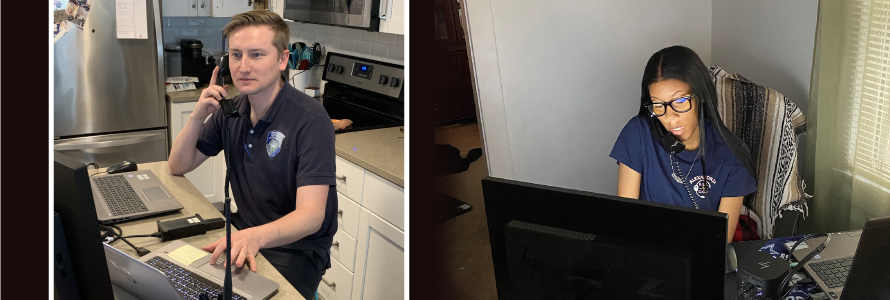The Nation’s 9-1-1 professionals are on the on the front lines of emergencies every day and play a vital role in keeping our communities safe and secure. As they take calls and gather essential information to determine a situation’s severity, public safety telecommunicators are using the FirstNet network to support innovative approaches to 9-1-1 and dispatch.
The nationwide network is built in public private partnership between the First Responder Network Authority (FirstNet Authority) and AT&T. It provides a dedicated, secure and reliable connection for public safety for everyday operations or emergency communications.
In the City of Alexandria, Virginia, which is a user of the FirstNet network, hotspots and smartphones powered by the FirstNet are enabling 9-1-1 dispatchers to take calls and handle Computer Aided Dispatch (CAD) operations from their homes and remote locations.
“The word is out about what we’re doing, and the phone rang several times yesterday with people around the country asking how we did it,” said Bob Bloom, the Public Safety Systems Administrator. “This has never been done before. Prior to 9-1-1, dispatching in the old days started in people’s homes and citizens would volunteer to answer calls for help. Then, they’d have to sound the alarm. They then called a number which also rang in the homes of certain fire officers. We’re full circle now with putting dispatchers back in their homes.”
Under this innovative approach, Alexandria’s remote dispatchers are using equipment that includes a laptop, headset and smartphone, FirstNet hotspot, mobile router with computer aided dispatch, and other necessary hardware. The hotspot with its FirstNet connection is critical to the operation, said Renee Gordon, Director of Department of Emergency & Customer Communications (DECC).
“We didn’t want to rely on people’s home internet because we know they can lose connectivity,” said Gordon. “We know we won’t lose connectivity with FirstNet.” Bloom agreed: “So if all hell breaks loose, we’re not going to lose connectivity to our home center. I sleep a little better with FirstNet.”
DECC Director Gordon said there were some concerns about the unknowns of remote call-taking, but the COVID-19 crisis spurred them into action. “We started planning and testing in January. We’ve had this equipment but never used it, and it’s been in the back of our minds that we need to explore this technology,” she said. “We did a lot of testing. Probably why others aren’t using it is because it’s scary. What happens if the call drops?”
The DECC implanted planning and testing to this approach in three distinct phases, and the remote capability went live on March 6. For the first month, the remote workers answered non-emergency phone calls only until they decided the system was working so that 9-1-1 calls could be handled as well.
“With the COVID-19 emergency we needed to separate our teams for social distancing,” said DECC Deputy Director Doug Campbell. “We broke the four shifts into two and two. Two in our primary ECC and two in our backup ECC which is always ready to go. Then we realized we needed to separate even more. So, Bob Bloom and his team went out to the dispatchers’ homes and set up the equipment.” DECC also set up a fourth team, called an isolation team, comprised of two fire dispatchers, two police dispatchers, and one call telecommunicator, staying and working at a nearby hotel for 10 days in a row.
The dispatcher at home accesses the department’s CAD system remotely via a connection to a laptop set up at their normal dispatching position back at the 911 center. The dispatchers remotely have the full functionality of the center at their fingertips. “It’s the same as what they have in the center, just a shrunken down version,” said Bloom. “They have RapidSOS, Smart911 and all the buttons at their fingertips. We put a talk group for 311 and 911 on the phones so it’s like being back in the center where you can share information.”
The remote call-takers and dispatchers work their regular 12-hour shifts. Bloom said from a functionality perspective, the remote employees are working the same way, except in a different location, and their call volume is the same. “Overall, they seem pretty happy with it,” he said. “There are some things we’ve tweaked and continue to tweak,” said Campbell. “We are happy to share our experiences and collaborate with other centers that are considering this functionality.”
As a member of the FirstNet Authority’s team of public safety experts, I am pleased to see the Alexandria using the network in innovative ways. As part of our public safety programs, the FirstNet Authority works closely with agencies around the country on lessons learned in operationalizing public safety broadband and to understand future critical communications needs for the FirstNet network. To learn more about to engage with us, please reach out to a FirstNet Authority public safety advisor in your area via FirstNet.gov for more information and opportunities.




















